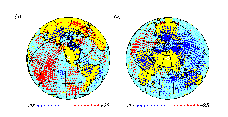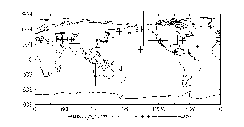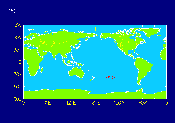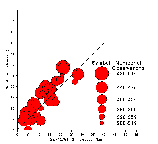Improving Teleseismic Event Locations Using a 3-Dimensional Earth Model
Gideon P. Smith1, and Göran Ekström
Department of Earth and Planetary Sciences, Harvard University,
Cambridge, MA 02138
1Now at Department of Earth and Planetary Sciences,
Washington Univ., St. Louis, MO 63108
Bull. Seism. Soc. Am., 86, 788-796, 1996.
Abstract
A comparison is made between seismic event locations derived from standard
spherically symmetric Earth models (JB, PREM, IASP91), and a recent Earth
model (S&P12/WM13) which incorporates large scale lateral heterogeneity
of P and S wave velocities in the mantle. Events with known
hypocentral coordinates are located in the different Earth models using
standard methods. Two sets of events are considered: a data-set of 26 explosions,
including primarily nuclear weapons test explosions and peaceful nuclear
explosions in the U.S. and former U.S.S.R.; and a published data-set of
82 well-located earthquakes with a more even global distribution. IASP91
and PREM are shown to offer similar errors in event location and origin
time estimates with respect to the JB model. The three-dimensional model
S&P12/WM13 offers improvement in event locations over all three one-dimensional
models with, or without, station corrections. For the explosion events,
the average mislocation distance is reduced by approximately 40%; for the
earthquakes the improvements are smaller. Corrections for crustal thickness
beneath source and receiver are found to be of similar magnitude to the
mantle corrections but use of station corrections together with the three-dimensional
mantle model provide the best locations.
Excerpts From this and Related Studies
 P-wave residuals predicted from the model S&P12/WM13 in the distance
range 20 degrees to 100 degrees. Maps are centered on (a) the Nevada and
(b) Kazakhstan nuclear test sites respectively. The predicted residuals
show good agreement with the observed ones but are generally slightly smaller.
The strong gradients of residuals evident in these pictures cannot be incorporated
in a simple 1-D structure and could have a significant effect on event
locations.
P-wave residuals predicted from the model S&P12/WM13 in the distance
range 20 degrees to 100 degrees. Maps are centered on (a) the Nevada and
(b) Kazakhstan nuclear test sites respectively. The predicted residuals
show good agreement with the observed ones but are generally slightly smaller.
The strong gradients of residuals evident in these pictures cannot be incorporated
in a simple 1-D structure and could have a significant effect on event
locations.
 Mean weighted teleseismic residuals beyond 30 degrees of the 108 test
events calculated using the S&P12/WM13 model. These residuals are generally
small and are evenly distributed about zero. This is to be expected when
minimising for the residuals, and does not imply anything about the quality
of the locations. For example, in the Aleutians the rms residual is small
because the large initial residuals from local source structure has been
mapped into a large mislocation vector.
Mean weighted teleseismic residuals beyond 30 degrees of the 108 test
events calculated using the S&P12/WM13 model. These residuals are generally
small and are evenly distributed about zero. This is to be expected when
minimising for the residuals, and does not imply anything about the quality
of the locations. For example, in the Aleutians the rms residual is small
because the large initial residuals from local source structure has been
mapped into a large mislocation vector.
 Mislocation vectors of explosions using the JB model with no elevation
corrections. The base of the arrow lies at the true location issued by
the test operators. The arrow points in the direction of the location found
by inversion of the travel-times. Arrow size is proportional to the mislocation
distance. A 15 km displacement is shown for scale.
Mislocation vectors of explosions using the JB model with no elevation
corrections. The base of the arrow lies at the true location issued by
the test operators. The arrow points in the direction of the location found
by inversion of the travel-times. Arrow size is proportional to the mislocation
distance. A 15 km displacement is shown for scale.
Mislocation vectors for PREM and IASP91 are similar to those shown in
the figure above. Addition of an elevation correction did not significantly
affect the solution in either regional mislocation bias or overall hypocentral
estimation. In all the 1-D models there appears to be systematic regional
mislocation directions resulting from a combination of regional deviations
from the average 1-D model and the station coverage. Most notable is the
south-west displacement of the locations in Eurasia, for which azimuthal
station coverage is poor, and the north-east displacement for events in
the American south-west for which station coverage is better. The strong
residual gradient predicted by the 3-D model (see figure below) helps to
remove the regional mislocation bias in North America. A similar effect
is seen in Eurasia.
 Mislocation vectors of explosions using the S&P12/WM13 model and
a simple two-layer crustal model.
Mislocation vectors of explosions using the S&P12/WM13 model and
a simple two-layer crustal model.
 Mislocation of explosions in km using model S&P12/WM13 versus mislocation
in km using PREM. The location errors are systematically smaller using
the S&P12/WM13 model. The root mean square of the location error is
roughly 40% lower in the case of S&P12/WM13 than in any of the spherically
symmetric models. Both the best rms origin time and the best location are
found using the S&P12/WM13 model.
Mislocation of explosions in km using model S&P12/WM13 versus mislocation
in km using PREM. The location errors are systematically smaller using
the S&P12/WM13 model. The root mean square of the location error is
roughly 40% lower in the case of S&P12/WM13 than in any of the spherically
symmetric models. Both the best rms origin time and the best location are
found using the S&P12/WM13 model.
 P-wave data alone has been used. Only earthquakes which have a large
number (>280) of reported arrivals are shown. Relocations of earthquakes
with lower numbers of observations are more scattered. The size of each
point relates to the number of arrival times used. Of interest is the observation
that the most improvement in location is generally observed for those events
that are observed by a larger number of stations. Although the distance
from the known location to the location found using the 3-D model is on
average smaller than the mislocation of the 1-D models the origin times
are not well fit. This is consistent with a constant offset in origin time
and agrees with the results of Kennett and Engdahl (1991) who attributed
the difference in arrival time to differences in the procedures used to
generate the hypocentral information for the earthquake events.
P-wave data alone has been used. Only earthquakes which have a large
number (>280) of reported arrivals are shown. Relocations of earthquakes
with lower numbers of observations are more scattered. The size of each
point relates to the number of arrival times used. Of interest is the observation
that the most improvement in location is generally observed for those events
that are observed by a larger number of stations. Although the distance
from the known location to the location found using the 3-D model is on
average smaller than the mislocation of the 1-D models the origin times
are not well fit. This is consistent with a constant offset in origin time
and agrees with the results of Kennett and Engdahl (1991) who attributed
the difference in arrival time to differences in the procedures used to
generate the hypocentral information for the earthquake events.
Until now, large scale mantle heterogeneities have been largely ignored
in event locations, except through indirect techniques such as the application
of station corrections. The results presented in this study suggest that
3-D mantle models now are of sufficient quality that incorporation of their
effects may be a more effective means of producing improved locations than
a continued search for better 1-D models. Not only are location and origin
time estimates improved but it has been shown that systematic location
biases due to large scale heterogeneities may also be partly accounted
for with the currently available 3-D mantle models. While the improvement
in location found for explosion sources is striking, the results for earthquakes
sources is marginal. The reason for this is unclear. One possibility is
that the original earthquake locations have larger errors associated with
them than we expect. This seems unlikely for a majority of the events,
since they initially were compiled specifically because of the quality
of their locations. A second explanation may be related to the fact that
most earthquakes occur along plate boundaries and in areas where velocity
heterogeneities are expected to be strong, for example in association with
subducted lithosphere. We can expect that for these events, a larger fraction
of the observed residuals accumulate in the smaller-scale, but strong and
localized heterogeneity near the source. Such residual patterns cannot
be well predicted by a model such as S&P12/WM13. If the second explanation
turns out to be the controlling one, potential for future improvements
exist in the development of higher resolution mantle models. While models
with globally uniform resolution (e.g. Ekström et al., 1994)
should lead to some improvement, hybrid models (e.g.
Fukao et al., 1992), which incorporate both the large-scale heterogeneity
associated with global structures and the small-scale regional variations
may hold the greatest promise.
 Mean weighted teleseismic residuals beyond 30 degrees of the 108 test
events calculated using the S&P12/WM13 model. These residuals are generally
small and are evenly distributed about zero. This is to be expected when
minimising for the residuals, and does not imply anything about the quality
of the locations. For example, in the Aleutians the rms residual is small
because the large initial residuals from local source structure has been
mapped into a large mislocation vector.
Mean weighted teleseismic residuals beyond 30 degrees of the 108 test
events calculated using the S&P12/WM13 model. These residuals are generally
small and are evenly distributed about zero. This is to be expected when
minimising for the residuals, and does not imply anything about the quality
of the locations. For example, in the Aleutians the rms residual is small
because the large initial residuals from local source structure has been
mapped into a large mislocation vector.
 P-wave residuals predicted from the model S&P12/WM13 in the distance
range 20 degrees to 100 degrees. Maps are centered on (a) the Nevada and
(b) Kazakhstan nuclear test sites respectively. The predicted residuals
show good agreement with the observed ones but are generally slightly smaller.
The strong gradients of residuals evident in these pictures cannot be incorporated
in a simple 1-D structure and could have a significant effect on event
locations.
P-wave residuals predicted from the model S&P12/WM13 in the distance
range 20 degrees to 100 degrees. Maps are centered on (a) the Nevada and
(b) Kazakhstan nuclear test sites respectively. The predicted residuals
show good agreement with the observed ones but are generally slightly smaller.
The strong gradients of residuals evident in these pictures cannot be incorporated
in a simple 1-D structure and could have a significant effect on event
locations.



